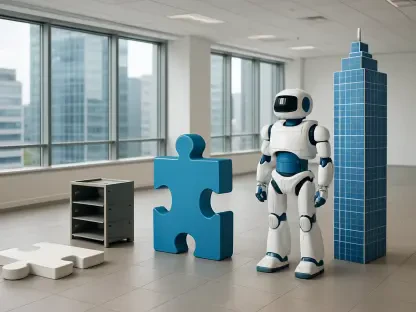The integration of machine learning (ML) into Human Resources (HR) is fundamentally shifting how organizations handle traditional HR tasks. From recruitment to employee engagement, the transformative potential of ML is vast, offering enhanced efficiency, reduced biases, and optimized workforce management. This exploration delves into the multiple facets of ML’s impact on HR strategies, highlighting both its promise and pitfalls. As the business world becomes increasingly reliant on data-driven decisions, HR departments are adopting sophisticated technologies to stay competitive and effective in managing their workforce.
The Rise of AI and ML in HR
Technological advancements have propelled the adoption of AI and ML across various business sectors, with HR being no exception. A recent IEEE study revealed that AI and ML are at the forefront of technologies organizations plan to integrate into their operations. One primary advantage of AI and ML in HR is the ability to automate routine administrative tasks, such as recruiting and maintaining employee records. These time-consuming activities can now be streamlined, freeing HR professionals to focus on strategic initiatives. This shift towards automation not only enhances operational efficiency but also allows HR teams to manage larger volumes of data more effectively.
The automation capabilities of AI and ML mean tasks that once took days or even weeks, like scanning resumes and scheduling interviews, can now be completed in a fraction of the time. This increased efficiency is crucial as HR departments deal with growing numbers of applicants and ever-complex workforce dynamics. Additionally, AI can analyze vast amounts of data to provide insights that would be impossible for humans to glean quickly. This capability enables more informed decision-making, whether it’s about recruitment, employee engagement, or workforce planning. The rise of AI and ML in HR is also pushing the industry to rethink traditional roles and workflows, fostering a more data-centric and forward-thinking approach to human resources management.
Enhancing Talent Acquisition
One of the most revolutionary applications of ML in HR is in talent acquisition. Companies like Unilever have demonstrated how ML can scan social media platforms to identify potential candidates based on predefined criteria. By leveraging ML algorithms, firms can parse through massive datasets, matching candidate profiles more precisely to open positions. This ability to sift through data efficiently leads to more accurate and faster talent scouting, which is essential in today’s competitive job market.
Machine learning goes beyond just identifying candidates; it also provides deeper insights into the kind of talent that the market offers. By analyzing patterns and trends in data, ML can uncover hidden gems—candidates who may not be actively searching for a job but match the company’s needs perfectly. This proactive approach to talent acquisition ensures that companies have a steady pipeline of qualified candidates, reducing the time and cost associated with traditional recruitment methods. Additionally, the use of predictive analytics in ML can forecast future hiring needs based on current trends, allowing HR to plan more effectively.
Streamlining the Recruitment Process
Machine learning doesn’t just find candidates; it also streamlines the entire recruitment process. From initial communication to document management, AI-driven systems can handle various steps of hiring, significantly reducing the time-to-hire. Chatbots are increasingly used to facilitate preliminary interactions with candidates, such as asking about skills, past roles, and salary expectations. These bots can efficiently categorize candidates for further consideration or exclusion, ensuring a more consistent candidate experience.
The automation of these tasks means that HR professionals can focus on the more nuanced aspects of recruitment, such as cultural fit and long-term potential. AI-driven systems can also offer insightful analytics on the recruitment process itself, identifying bottlenecks and areas for improvement. This data-driven approach enables HR departments to fine-tune their strategies continually, making the recruitment process more efficient and effective. Moreover, the use of machine learning in recruitment helps ensure a level playing field for all candidates, as it eliminates human biases in the initial screening stages.
Reducing Recruitment Bias
AI and ML hold the promise of minimizing unconscious biases in recruitment. By anonymizing candidate information that could lead to subjective decisions, these technologies aim to create a more objective evaluation process. However, the benefits of reducing bias are contingent on the data used to train these algorithms. If the data is biased, the AI system may perpetuate existing prejudices. This issue was notably highlighted by Amazon’s failed AI recruitment system, which showed bias against women, underscoring the need for robust data review practices.
To mitigate these risks, it’s crucial to implement multi-layered approaches that include both machine learning and human oversight. While AI can eliminate some forms of bias, human professionals are needed to ensure that the data used is diverse and representative. Regular audits of AI systems can help detect and correct biases that may have been unintentionally built into the algorithms. By combining the strengths of machine learning with the critical thinking and ethical considerations of human oversight, HR departments can strive for a more equitable and inclusive hiring process.
Optimizing Workforce Management
Beyond recruitment, ML helps HR teams optimize workforce management. By analyzing various factors, such as skill sets, workload distribution, and business needs, ML algorithms can devise efficient workforce planning strategies. These tools not only enhance resource allocation but also aid in scheduling, ensuring that the right talent is available when needed. This proactive approach enables businesses to respond dynamically to workforce demands, resulting in better staff utilization and overall effectiveness.
ML can also predict workforce trends and potential issues before they become problematic. By analyzing historical data, machine learning models can forecast employee turnover, identify departments at risk of becoming understaffed, and suggest measures to address these challenges. This capability allows HR departments to be more strategic and less reactive, focusing on long-term planning rather than fire-fighting short-term issues. Furthermore, the insights gained from ML can help in designing training programs and development plans that are tailored to the needs of the workforce, thereby enhancing overall productivity and job satisfaction.
Boosting Employee Engagement
HR professionals are increasingly using machine learning to gauge employee engagement and morale. By analyzing data points related to job satisfaction, workload, and interactions with managers, ML systems can predict factors leading to employee turnover. These predictive insights allow HR departments to intervene early, implementing measures to improve job satisfaction and reduce attrition rates. This focus on employee well-being not only boosts morale but also enhances productivity and retention.
Machine learning can also help HR departments understand what drives employee engagement in their specific organization. By identifying trends and patterns, ML can offer actionable recommendations for improving workplace culture, such as introducing flexible working hours or targeted training programs. These insights are invaluable for creating a more supportive and inclusive work environment. Additionally, machine learning can provide real-time feedback mechanisms, allowing employees to voice their concerns and suggestions directly. This continuous loop of feedback and improvement helps foster a more engaged and motivated workforce.
Navigating the Challenges of ML in HR
Machine learning (ML) is revolutionizing Human Resources (HR) by fundamentally transforming how companies manage traditional HR activities. From hiring processes to employee engagement, ML’s far-reaching potential offers significant improvements in efficiency, reduction of biases, and streamlined workforce management. This evolution highlights ML’s impactful role in modernizing HR strategies by emphasizing both its advantages and possible drawbacks.
As businesses increasingly depend on data-driven decisions, HR departments are integrating advanced technologies to remain competitive and effective. For instance, ML can automate resume screening to identify the best candidates quickly, reducing time-to-hire and minimizing human biases. It also enables predictive analytics to forecast employee turnover, helping organizations proactively address retention issues. Furthermore, ML-driven chatbots can enhance employee experiences by providing immediate, personalized responses to HR-related inquiries.
However, the adoption of ML in HR isn’t without challenges. Concerns regarding data privacy, algorithmic transparency, and the ethical implications of automated decision-making must be addressed. Balancing the benefits of ML with these considerations is crucial for HR departments aiming to leverage this technology effectively. As organizations continue to embrace data-centric strategies, the role of ML in HR will likely expand, shaping the future of workforce management.









